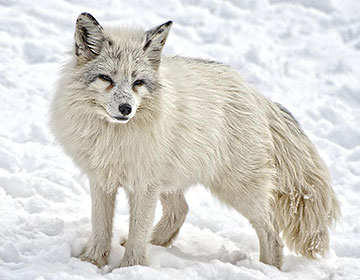How the Arctic fox survives life in the frozen North
- Nature Conservation
- Land Conservation
- Iconic Species
- Wildlife
- Mammals
- Alaska
- Subarctic America Realm
One Earth’s “Species of the Week” series highlights an iconic species that represents the unique biogeography of each of the 185 bioregions of the Earth.
Throughout the Arctic tundra biome and the sea-ice caps, the Arctic Fox, Vulpes lagopus, roams. It is a small fox native to the circumpolar region of the Northern Hemisphere.

The Arctic fox is the iconic species of the Greater Alaska Taiga & Tundra Bioregion (NA4).
Unique features
Also known as the polar fox, the Arctic fox can measure from 46 to 68 centimeters (18-27 in) long and weigh between 2.7 and 4.5 kilograms (6-10 lb). It has a bulky, fluffy-looking body and a long, furry tail.
The nose of the Arctic fox can detect a ‘resource hotspot like marine carrion’ as much as 40 kilometers away. Its ears are small and pointed forward, enabling them to hear acutely. For instance, they can stand on a pack of snow and listen for their favorite prey, the lemming, as it moves through tunnels, and when it’s right beneath, they will pounce.
Fur can be blue or white. This feature is genetic and depends on the color of the parents. A blue coat is a charcoal tone that acquires light tonalities in winter. The white coat is as pure as snow and remains this color during summer.
Adapted for extreme cold
The physiological and anatomical adaptation of the Arctic fox helps keep its body temperature near 38 °C (100 °F). Organs are insulated from the cold by a thick fat tissue built up during the autumn, which, together with the thickened winter fur, increases their body weight by more than half.
Their long, thick, furry tail protects them from the cold during blizzards and below-freezing temperatures. The fox curls up tightly with its legs and head under its body, covered by the tail.
Like many four-legged mammals, including domestic dogs, their paws are kept at a lower temperature than their body core. The paws of the Arctic Fox grow dense fur at the beginning of the winter, which sheds in springtime. The species name ‘lagopus’ indicates this particular feature in the Latin language: “rabbit footed.”
.jpg)
An omnivorous diet
Foxes have a varied diet. They feed primarily on two small rodent species, the lemming and the tundra vole. On the coast of Alaska, during the warm months, they roam the rocky shores preying on nesting seabirds such as auklets, puffins, and murres from whom they also take their eggs.
In northwest Europe, north of Svalbard, lead formations on the pack ice act as hot spots attracting amphipods, sea birds, and marine mammals, such as ringed seals, hooded seals, narwhals, and bowhead whales. They have been spotted eating the leftover of the polar bear’s hunt in such places.
In the Tundra, they eat insects, berries, and even droppings of animals if they are hungry. When there is plenty of food, they sometimes hide a piece of their hunt among boulders or inside their den.
Reproduction and parenting
Arctic fox adults are monogamous for life, and parenting is shared in rearing needs. Foxes become sexually mature at ten months, coinciding with the first mating season from early March to April. After that, they prepare the den where they will care for their pups.
Dens are traditionally made in special grounds called eskers, made of sedimentary deposits from formerly glaciated surfaces, and are frost-free, sandy, and well-drained. Beneath the eskers are tunnels in all directions that can extend to 1,000 square meters (11,000 sq. ft) and be in active use over generations.
Gestation takes 52 days, and after pups are born, both parents provide rearing care. At three weeks, they begin to emerge from the den in the company of their parents. After a month of lactation, both parents take turns bringing meat to the pups, and then, little by little, pups get trained to hunt.
At the end of summer, young foxes are ready to begin ranging on their own, although they will remain close to the rest of the family group. Depending on their skills and luck, young foxes may survive the following spring, when they choose a mating partner to become parents for the first time in their cycle.
.jpg)
Migration pattern
In fall and early winter, Arctic foxes travel seawards, while in late winter, they tend to range in the opposite direction. They can roam for kilometers on the sea ice while following the trails of hunting animals, scavenging the carcasses of marine mammals and reindeer.
Their exceptional mobility and endurance in barren polar environments have been proven to be a behavior beyond a seasonal migration pattern. Studies about the movement of foxes have “demonstrated the extensive use of sea ice as a foraging habitat and as a platform for exploration and dispersal,” according to Eva Fuglei and Arnaud Tarroux, two scientists from Norway.
A research study followed a female polar fox beginning in July 2017. She was ear tagged close to her natal den near the front of the glacier Fjortende Julibreen, in Krossfjiorden, on the largest island in the High-Arctic Svalbard Archipelago, Europe.
The tracking period lasted almost a year. Until March 2018, she roamed a considerable area along the coastline of western Spitsbergen. Then she began to move beyond the region she was familiar with and took to cross a large mass of sea ice in north-western Greenland towards the west.
By the following year, the young female had covered a total cumulative distance of over four thousand kilometers!
Population size
Foxes have considerably large litters, with seven on average but up to fifteen or more pups. The survival rate in the first year is low but depends on food availability.
Despite the greed of its human predator (the commercial hunter), and the very high numbers of ‘harvested’ foxes per year some decades ago, they are widespread in some areas. Their natural predators are wolverines, red foxes, polar bears, and golden eagles.
According to the International Union for the Conservation of Nature, the status of the population is of Least Concern. Although the population trend is unknown, it is “most likely stable.”
Importance to Indigenous Peoples
Both the white and blackish blue fur have been of exceptional value to all Indigenous peoples in the Arctic: the Haida, Aleut, Inuit (Iñupiat), and Yupik Peoples in Alaska, the Inuit (Kalaallit) in Greenland, the Saami in circumpolar Scandinavia and the Nenets, Khanty, Evenk and Chukchi in Russia.
As with seals, caribou, polar bears, and wolves, Indigenous communities take the animals’ lives with respect and care to use every part for food, medicine, and clothing. They also have legends and myths about the fox’s exploratory nature and tenacity to resist the cold weather.
.jpg)
Conservation amidst climate change
Today, 13.1 million people live in the circumpolar North area who come from generations that have traditionally harvested, hunted, and fished. For at least three decades, the Indigenous people and arctic fauna are all experiencing the effects of the thinning and disappearing of sea ice and climate change, such as rapid weather changes and strong winds and storms.
Under these conditions, animals that depend on ice cover live under permanent stress and threat. Likewise, the livelihoods of hunters, herders, and fishermen are significantly affected, impacting their economy, housing infrastructure, culture, social fabric, and individual and collective health.
One Earth is proud to support two organizations helping improve life in the Arctic for both wildlife and its people, Global Choices and Hearts in the Ice. Efforts like these conserve and protect the Arctic fox and all who call its habitat home.
Explore the Bioregions.jpg?auto=compress%2Cformat&w=1440)


